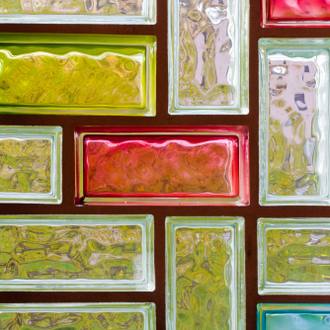Specialist glass – opaque, stained glass, etc
Index
Sometimes you want something fancier than a clear glass window or splashback in your home. You made want something special, either for decorative, safety or environmental reasons. There are a number of different specialist glasses and glazing options for a variety of purposes.

Opaque or frosted glass
Frosted or opaque glass is created through various processes, often through sandblasting or acid etching, that roughen the clear surface of the glass. It still lets light through, but visibility is obscured. Not only is it an attractive decorative option, but it provides a level of privacy, especially in bathrooms and bedrooms. It also doesn’t show hand or fingerprints, and is easy to keep clean. Frosted glass film can achieve the effect on clear glass. Smart glass can turn clear glass into an opaque. Frosted glass can also be toughened or laminated to make it safer.
Stained glass
Stained glass is of course closely associated with churches and their stained glass windows. Clear glass is coloured by adding metallic salts during manufacture. That glass is then cut into pieces and assembled with different coloured glass to form a patterned window. They are highly decorative, and can provide a feature window in homes or buildings, and can be used in other glass products other than windows. A more contemporary version of stained glass is coloured or tinted glass, usually achieved with transparent coloured laminates applied to clear glazed windows. Specialist glaziers are experienced in creating and installing stained or tinted glass.
Leadlight
Leadlight windows are similar to stained glass, as they’re both decorative and involve patterns formed by pieces of different coloured glass. Leadlight however uses lead between the glass panels, which is then soldered together. Often used as featured panels in doors, or in glass windows, they were very popular in Victorian, Edwardian, Art Deco and post-war homes. They are usually patterns and designs rather than the pictures stained glass is used for, and used primarily to create atmosphere, and sought after for period renovations. Leadlighting is also an artform in itself, and there are many craftspeople and groups that produce leadlight windows.
Safety and environmental glass
Less decorative but equally important specialist glass types include safety glass, which includes toughened glass, wired glass and safety laminate glass. These meet the Australian Standard introduced in 1989, and are used in homes and commercial properties, both inside and outside. It is often used for splashbacks and glass balustrades. Double glazing is another form of specialist glass; glazed windows that help insulate interiors from changing air temperatures. These can also be made safer with a safety laminate, and can also be treated with a thermal membrane to reduce UV rays. Smart glass and tinted glass can also protect against the elements; smart glass can turn from clear to opaque or tinted glass with the touch of a button, and provides protection from sun glare, and privacy.
For more information about different types of glass, contact a glazier near you.
